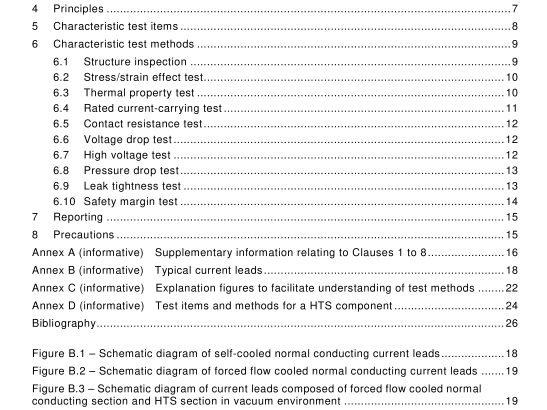IEC 61788-14:2010 pdf download – Superconductivity – Part 14: Superconducting power devices – General requirements for characteristic tests of current leads designed for powering superconducting devices
6.2 Stress/strain effect test
6.2.1 Purpose This test shall confirm the mechanical stress/strain effect on the current leads at room temperature and low temperatures.
6.2.2 Methods A mechanical stress/strain level at room temperature and low temperatures in the target system shall be simulated, and mechanical stress/strain is loaded up to the maximum level below the elastic limit of the superconductor.
NOTE 1 The maximum load should be defined depending on the safety margin, and is typically 1 ,1 times the specification level.
NOTE 2 The test should be done repeatedly a specified number of times by distinguishing the condition between electromagnetic loading and thermal loading.
NOTE 3 Special notice should be taken of internal stress/strain appearing due to the cooling of the current leads from room temperature to operating conditions.
6.2.3 Results Test results shall be collated with the specifications and fully reported.
6.3 Thermal property test
6.3.1 Non-current heat leakage test
6.3.1 .1 Purpose This test shall measure the non-current heat leakage, which is observed at zero current without any Joule heating, associated with the heat conduction from the room-temperature end to the intermediate-temperature portion, from the intermediate-temperature portion to the low-temperature end or from the room-temperature end to the low-temperature end of current leads.
6.3.1 .2 Methods The heat leakage shall be measured by the evaporation method of liquid cryogen, the enthalpy change method of forced flow cryogenic gas or the thermal conduction method using a cryocooler, depending on the cooling condition of the testing current leads.
a) Evaporation method The current leads are installed in a special cryostat for the heat leakage test with known values of background heat leakage into the measurement region. In the cryostat the cold ends of the current leads are cooled with an appropriate coolant such as liquid helium and/or liquid nitrogen. The mass flow rate of evaporated coolant is measured at the outlet of the cryostat. The heat leakage through the current leads is evaluated by analyzing an increment in the mass flow rate of evaporated coolant by installing the current leads. Corresponding measurements should be carried out in the case of the intermediate-temperature portion.
b) Enthalpy change method The current leads are installed in a cryostat with known values of background heat leakage into the measurement region. The temperature and mass flow controlled forced flow cryogenic gases such as supercritical helium are supplied to the cooling portions of the current leads. The heat leakage through the current leads is evaluated by the enthalpy changes of cryogenic gases between inlet and outlet of the current leads.
c) Thermal conduction method The current leads are installed in a cryostat with known values of background heat leakage into the measurement region. The cooling portions of the current leads are thermally connected to the cold heads of the cryocooler. The heat leakage through the current leads is evaluated by the increment of heat loads to the cold heads of the cryocooler.
NOTE 1 In the evaporation method, a part of evaporated coolant remains in the cryostat as a low-temperature gas. Because the density of a low-temperature gas is large, it is necessary to correct the amount of the evaporated coolant when the mass flow rate is measured at the outlet of the cryostat.
NOTE 2 In R&D, the value of the heat leakage through the current lead is estimated from the numerical solution of the energy balance equation along the conductor of the current lead. Temperatures of cold and warm ends are taken to be boundary values of the energy balance equation. The form of the energy balance equation depends on the structure of the current leads. In the case of the gas-cooled normal conducting current leads, the energy balance equation may consist of such terms as heat conduction, ohmic heat generation and heat exchange with cooling gas.
